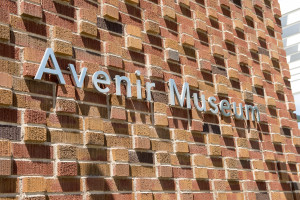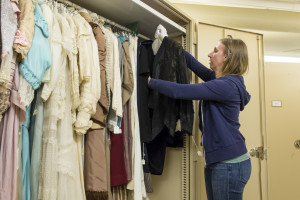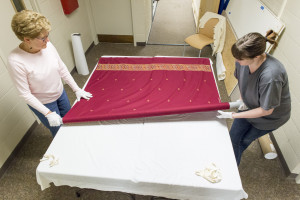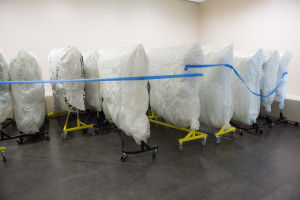One of Colorado State University’s most valuable and precious assets — its enormous textile and historic clothing collection of about 20,000 items — is getting settled into a new and improved home.
The Avenir Museum of Design and Merchandising, located east of the University Center for the Arts, has undergone a striking transformation over the past 18 months. It involved remodeling about 8,000 square feet in the current Avenir facility and adding 10,000 square feet, allowing for two galleries, classroom and seminar space, a library, a conservation laboratory and expanded collection storage and management areas. The expansion of storage cabinetry was made possible by a generous bequest from the estate of prominent fashion designer and critic Richard Blackwell.
“We’ve more than doubled our footprint,” said Doreen Beard, the Avenir Museum’s director of operations and engagement.
 But before the project could begin, the thousands of artifacts had to be relocated in December 2013 to the former Centers for Disease Control and Prevention facility on the Foothills Campus. It proved to be an appropriate temporary storage area for the collection, since it is secure and relatively climate-controlled, new Avenir Museum Curator Megan Osborne said.
But before the project could begin, the thousands of artifacts had to be relocated in December 2013 to the former Centers for Disease Control and Prevention facility on the Foothills Campus. It proved to be an appropriate temporary storage area for the collection, since it is secure and relatively climate-controlled, new Avenir Museum Curator Megan Osborne said.
The collection was moved back to the bigger and better Avenir Museum in June. Volunteers and staff will spend the coming months getting all of the pieces properly situated in their new storage and gallery areas before the museum opens in early 2016 with several exhibitions, including one featuring recently donated Guatemalan textiles and another highlighting the quilt work of CSU alumna Lucile Hawks.
Accommodating growth
For Osborne, it’s the fourth time she has helped relocate the collection. The 2004 CSU apparel and merchandising graduate got her master’s in the history of decorative art, with a concentration in costumes and textiles, from the Corcoran College of Art and Design in Washington D.C., where she worked for the Smithsonian Institution and the Daughters of the American Revolution Museum. She was hired by CSU in 2009 to help unpack after the move from the Gifford Building to the UCA East location, serving in various roles since then, and was recently named curator for the collection. In Gifford, the only storage area was the room that is now the Gustafson Gallery.
“It was really crammed in,” Osborne said. “We were over-committed at Gifford.”

Since then, the collection has grown by more than 7,000 pieces.
“And every piece we take in requires great care and ongoing funding to preserve it,” she explained, opening one of the new storage cabinets to reveal an array of men’s and women’s clothing from the 1890s.
Osborne moved on to another new cabinet containing wide, flat drawers. Eventually each will contain a single beaded dress — improved accommodations for apparel that over time can stretch and rip under the weight of the beads if hung vertically.
One of the older pieces in the collection, she said, is a nightgown inscribed with the name of its owner, Rebecca Tyler, and the year, 1803 — when Thomas Jefferson was president.
The Avenir, a French word for “future” pronounced “ah-veneer,” is a teaching facility where CSU students, scholars and community members can engage in hands-on learning and research, and where stories about people and what their textiles mean to them can be woven together.
Beard said that with the popularity of TV shows like Downton Abbey, a whole new generation of young people is becoming more interested in the apparel of previous eras, and how it was made.
Outside a room packed with containers of clothing, Osborne and Beard consulted an extensive, detailed Excel spreadsheet documenting every single piece in the collection, where it came from, and where it belongs in the new facility.

Nearby, volunteer Terrie Cornell and graduate student Jessica Sholts were busy rolling rugs; the textiles need to be periodically unfurled and re-rolled in the opposite direction to alleviate “internal crush,” which occurs when the fibers are compressed and stretched.
Among the facility’s new features that are expected to strengthen the Avenir Museum’s bid to gain accreditation from the American Alliance of Museums is a coiling garage door that can accommodate large deliveries and rolls up inside a ceiling tube.
Nearby, rows of white mannequins fill one storage room, eerie-looking without their clothing.
“It’s kind of creepy when the lights are off,” Osborne said.
Public spaces
Aside from the enhanced behind-the-scenes storage areas and equipment, the public-facing areas of the teaching museum make an impression. In the lobby, against wood paneling, metal and wood latticework designed to look woven shows off the names of donors who made the project possible.
A large classroom featuring three wide-screen monitors has been equipped with technology that will allow students to observe the tiniest details of textile conservation work as it goes on in the conservation lab across the hall, thanks to a microscope camera and live video feed.
 In the library, where an extensive reference collection can be consulted by appointment, a section of what appears to be wall paneling is actually a tall cabinet door that opens to reveal a sink and coffee service area for large meetings. The room features colors chosen for their resemblance to original sources of natural dyes. (A garden of plants that yield natural dyes is planned on the east side of the building.)
In the library, where an extensive reference collection can be consulted by appointment, a section of what appears to be wall paneling is actually a tall cabinet door that opens to reveal a sink and coffee service area for large meetings. The room features colors chosen for their resemblance to original sources of natural dyes. (A garden of plants that yield natural dyes is planned on the east side of the building.)
The undulating brick patterns on the exterior of the building change with the light, evoking images of the various textures and weaves found within.
In May, about 70 people attended a sneak-peek open house at the new Avenir Museum, which is part of the Department of Design and Merchandising in the College of Health and Human Sciences.
As for the rest of the campus and Northern Colorado community, their first glimpse of the collection’s new home won’t come until early 2016.
But it will be worth the wait.
Like the Avenir Museum on Facebook or sign up to receive email updates from the museum.